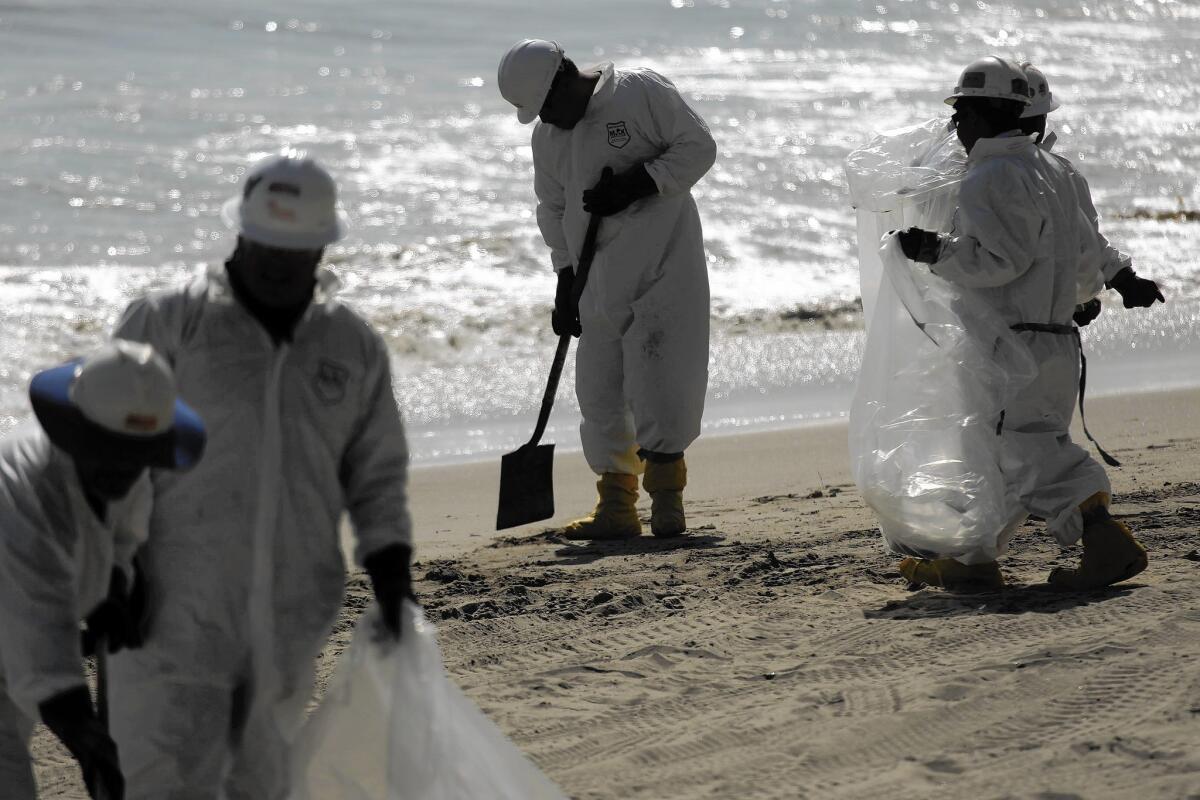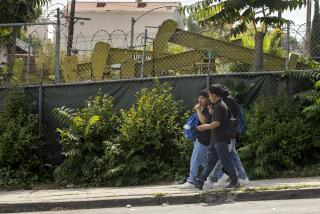Feds order pipeline company to clean up Santa Barbara coastline

- Share via
Reporting from Santa Barbara — Federal authorities Wednesday issued a cleanup order to the company whose underground pipeline spilled thousands of gallons of crude oil into the Pacific last week, marring several miles of Santa Barbara County coastline.
“There may not be oil on the beach like there was on the first few days, but there is still a problem,” Jared Blumenfeld, administrator for the U.S. Environmental Protection Agency’s Pacific Southwest region, said at a news conference. “That problem needs to be cleaned up. The oil all needs to be removed.”
Under the order from the EPA and the U.S. Coast Guard, Plains All American Pipeline, which owns and operates the pipeline, must continue its cleanup on land, on the beach and in the ocean. The order requires the company to clean up all remaining contamination and to contain the oil to ensure no more crude is released.
The cleanup order came as Santa Barbara-area business groups expressed anxiety about the oil spill hurting tourism in the region. More than 6 million people a year visit Santa Barbara County’s south coast, from Gaviota to Summerland, mostly during the summer months, said Karna Hughes, a spokeswoman for the marketing organization Visit Santa Barbara.
The spill released as much as 101,000 gallons of crude from the pipeline, according to the company, with an estimated 21,000 gallons of oil flowing downhill from the spill site through a culvert, under U.S. 101 and into the Pacific.
The federal order issued Wednesday establishes timelines and cleanup requirements under the federal Clean Water Act. Officials say the move will ensure a prompt and thorough restoration of ocean waters and shoreline fouled by the May 19 spill near Refugio State Beach.
By June 6, the company must submit a work plan and detail how it will sample the air, water, rocks and soil.
Rick McMichael, senior director of pipeline operations at Plains All American Pipeline, said the company will comply with the order.
Cleanup operations along the beach have swelled to nearly 1,000 people, including federal and state employees, environmental contractors hired by Plains and trained volunteers.
On Wednesday, Plains continued a slow-moving excavation of the soil around the section of pipe that broke. A separate order issued Friday by the federal Pipeline and Hazardous Materials Safety Administration requires the company to remove that portion of the pipeline to determine what caused the rupture and the condition of the pipe when it failed.
The company has also said it will investigate the integrity of its pipe at four other locations along Line 901, which transports crude oil 11 miles from Las Flores to Gaviota and then to refineries throughout Southern California.
For the last week, just at the onset of the summer tourism season, news coverage of the Santa Barbara spill has dispatched images of oil-covered birds and the sticky black shorelines of Refugio and El Capitan state beaches. The region’s hotel and travel industry representatives say those images pose a looming problem.
Visit Santa Barbara has been calling travel magazines to inform them that the oil spill is mainly limited to the two state beaches more than 20 miles from Santa Barbara and to assure them that hotels, beaches and recreational businesses elsewhere in the county are still open, Hughes said. There hasn’t been a noticeable drop in visitors to the area, she said, but the group is polling local businesses to determine the spill’s effect.
Some hotels, tour outfits and other tourism businesses have experienced cancellations and received phone calls from worried customers who want to know if all beaches in the Santa Barbara region are fouled with oil, said Warren Butler, president of the Greater Santa Barbara Lodging & Restaurant Assn.
“There is concern about a perception that is overexaggerated: That there’s this big oil spill that’s affecting Santa Barbara County,” Butler said. “In reality it’s contained within a small area. It’s a major tragedy, but it has to be kept in perspective.”
The oil is concentrated along several miles of the Gaviota Coast near Refugio and El Capitan state beaches. Those beaches remain closed until June 4, but Eric Hjelstrom, state parks superintendent for the Santa Barbara area, said the closure is likely to continue another week into June.
“We are hoping they open up Refugio as soon as possible,” said Michael Cohen, owner-director of Santa Barbara Adventure Co., which offers kayak tours. “We are heading into the busy months.”
The latest survey showed 4.6 miles of shoreline were still heavily affected by the spill and up to 8.9 miles were lightly impacted, U.S. Coast Guard Capt. Jennifer Williams said.
Responders have rescued 33 oiled birds and recovered 16 dead birds, mostly brown pelicans. Eighteen oiled marine mammals, including sea lions and elephant seals, are being rehabilitated and nine have died, according to the state Department of Fish and Wildlife.
Twitter: @jpanzar, @tonybarboza
More to Read
Sign up for Essential California
The most important California stories and recommendations in your inbox every morning.
You may occasionally receive promotional content from the Los Angeles Times.












